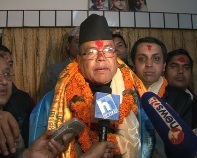By Shastri Ramachandaran*
IDN-InDepth NewsAnalysis
KATHMANDU (IDN) – The sham that multiparty democracy has become in Nepal is turning into a cruel joke on the people. The resignation of Prime Minister Jhalanath Khanal of the Communist Party of Nepal-Unified Marxist Leninist (CPN-UML) underscores how voters are stuck with a self-serving elected elite, no less privileged and protected than the ousted monarchy.
The resignation of Khanal, as much as his continuation since May 29 (when he had promised to step down, but did not), exemplifies the collective opportunism of Nepal’s three major parties.
The 2008 election – which saw the Unified Communist Party of Nepal-Maoists (UCPN-M) emerge as the single largest party – seems to have created a new, cretinous ruling class. The sole aim of this 601-member club class, otherwise known as the Constituent Assembly (CA), is to hold the country, state and people hostage to keep their status as ‘people’s representatives’.
The Nepali Congress (NC), the UCPN-M and the CPN-UML differ on every issue except when it comes to keeping themselves in elected office by one arrangement or another. Thus, the purpose of the CA appears to have been forgotten.
When the Maoists (UCPN-M) formed the government after the 2008 election, the CA committed itself to concluding the peace process, delivering a draft constitution and creating conditions for electing the republic’s first parliament. However, there was no progress on either of these two principal tracks.
At the helm of government, Maoist supremo Prachanda, as Pushpa Kamal Dahal is known, achieved little. He was stonewalled on the floor of the assembly and then within his own party on the terms of the constitution and rehabilitation of his cadres. He had to step down.
At the end of two years, with none of the parties ready to face the fury of a hoodwinked people, the CA voted to extend its own life by a year. But even at the end of 36 months, there was no sign of the draft constitution. Nor was the Comprehensive Peace Agreement implemented.
In fact, the one-year extension of the CA would be remembered for an extraordinary charade: the 17 futile rounds of voting over several months to elect a prime minister, before a compromise made Khanal prime minister in February 2011.
When the CA’s extended term ended on May 28, there arose a clamour for Khanal’s resignation. The CA gave itself another three months and, on May 29, Khanal promised to resign after the Maoists, the NC and the CPN-UML signed a five-point agreement.
The deal included Khanal’s resignation to make way for a government of national unity; conclusion of the basics of the peace process; and, preparation of a first draft of the new constitution. As in earlier agreements with Madhesi parties, this deal also promised to make the Nepal army more inclusive.
No sooner had the ink dried on the agreement than Khanal reneged on his commitment. He managed to continue in office arguing that his resignation, in the absence of an alternative, would be destabilising. Therefore, the three big parties conspired to bury the spirit and the purpose of their mandate; and, let Khanal continue.
As a survival tactic, Khanal did the bidding of the Maoists. Unmindful of protests by his own party and the NC, he allowed the Maoists to change their nominees in his council of ministers. Having placated Prachanda, Khanal tried to pressure the Maoists by saying that he would resign on August 13 if there was no concrete progress in the peace process.
By now, his actions had alienated influential sections of his own party, which wanted him out as much as the Nepali Congress and the Maoists. However, the NC, unlike the Maoists, was opposed to a further extension of the CA’s term. Khanal hoped to exploit this difference and continue until August 31, when the term of the House would end, and the resulting crisis could herald another open season.
But with all sides accusing him of betrayal, Khanal who, on August 13, had refused to quit until there was consensus on a new government, resigned the next day.
Nepal is now caught in a crisis that can only worsen before the situation improves. The peace process is stalled. Most provisions of the Comprehensive Peace Agreement remain unimplemented. There is no acceptable draft of the constitution, no agreement on dealing with the 19,000 Maoist combatants or on the federal structure to be created.
Amidst this unravelling crisis, President Ram Baran Yadav had asked the CA to elect a new prime minister before August 21 even as doubts grow about the existence of the Constituent Assembly beyond August 31.
There are no certainties in Nepalese politics. On the contrary, Nepalese politicians thrive on uncertainties. How the events play out and which party and personalities prevail is being watched with much interest in China as well as in New Delhi.
*The author is a political and foreign affairs commentator who has covered developments in Nepal for over 20 years. He is co-editor of the book ‘State of Nepal’. A version of this article appeared on dnaindia. (IDN-InDepthNews/22.08.2011)
2011 IDN-InDepthNews | Analysis That Matters
Follow us on Twitter and Facebook:
http://twitter.com/InDepthNews
http://www.facebook.com/pages/IDN-InDepthNews/207395499271390?sk=wall

